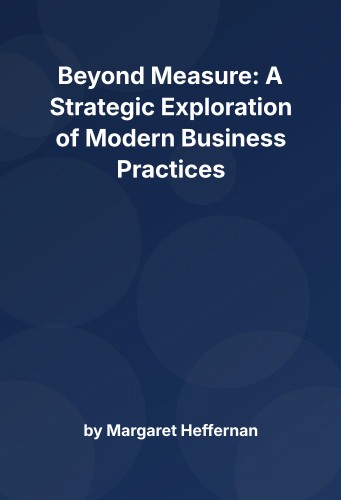Beyond Measure: A Strategic Exploration of Modern Business Practices
Margaret Heffernan’s “Beyond Measure” delves into the intricate dynamics of professional environments, offering readers a comprehensive guide to cultivating meaningful change and sustainable growth in the business world. This summary distills the book’s key themes and insights into actionable strategies for professionals, emphasizing transformation, innovation, and leadership in the digital age.
The Power of Intangible Assets
In an era where technology and data dominate the business landscape, Heffernan highlights the crucial role of intangible assets—such as culture, trust, and human capital—in driving success. She argues that while metrics and analytics are essential, the true competitive edge lies in harnessing the power of human relationships and creativity. This perspective aligns with the principles of Daniel Kahneman’s “Thinking, Fast and Slow,” where the emphasis on human intuition and decision-making complements the data-driven approach.
Building a Culture of Trust
Trust is the cornerstone of any successful organization. Heffernan emphasizes that fostering a culture of trust requires transparency, open communication, and a commitment to ethical practices. By creating an environment where employees feel valued and heard, organizations can unlock innovation and resilience. This approach mirrors the findings in “The Speed of Trust” by Stephen M.R. Covey, which underscores the economic benefits of trust in business relationships.
Leveraging Human Capital
Human capital is an organization’s most valuable asset. Heffernan advocates for investing in employee development and well-being, recognizing that a motivated and skilled workforce is key to achieving strategic objectives. This concept is echoed in “The Human Equation” by Jeffrey Pfeffer, which argues that treating employees as partners rather than mere resources leads to better performance and profitability.
Embracing Complexity and Uncertainty
Heffernan encourages professionals to embrace complexity and uncertainty as opportunities for growth rather than obstacles. In a rapidly changing world, agility and adaptability are essential traits for organizations seeking to thrive.
Navigating the Digital Transformation
Digital transformation is reshaping industries, and Heffernan provides a roadmap for navigating this shift. She emphasizes the importance of aligning digital initiatives with organizational goals and fostering a culture of continuous learning. This perspective is in line with “Leading Digital” by George Westerman, Didier Bonnet, and Andrew McAfee, which outlines how companies can harness digital technologies to drive transformation.
The Role of Agility in Business Strategy
Agility is crucial for responding to market changes and seizing new opportunities. Heffernan discusses how agile methodologies, such as those popularized by “The Lean Startup” by Eric Ries, can be applied beyond product development to enhance strategic decision-making and operational efficiency.
Leadership in the Modern Workplace
Leadership plays a pivotal role in shaping organizational culture and driving change. Heffernan explores various leadership styles and their impact on employee engagement and performance.
Transformational Leadership
Transformational leadership, characterized by inspiring and motivating employees to exceed expectations, is essential for fostering innovation and change. Heffernan draws parallels with “Good to Great” by Jim Collins, which highlights the importance of visionary leadership in achieving sustained success.
Leading with Empathy
Empathy is a critical trait for modern leaders. By understanding and addressing the needs and concerns of employees, leaders can build stronger teams and improve organizational performance. This approach is supported by “Emotional Intelligence” by Daniel Goleman, which emphasizes the role of emotional intelligence in effective leadership.
Strategic Frameworks for Professional Growth
Heffernan introduces several frameworks and models to guide professionals in developing strategic insights and achieving their goals.
The Innovation Matrix
The Innovation Matrix is a tool for identifying and prioritizing innovation opportunities. By mapping potential projects based on their impact and feasibility, organizations can focus their resources on initiatives that offer the greatest strategic value. This framework complements the ideas presented in “Blue Ocean Strategy” by W. Chan Kim and Renée Mauborgne, which advocates for creating uncontested market space through innovation.
The Feedback Loop
Feedback is essential for continuous improvement. Heffernan outlines a structured approach to gathering and utilizing feedback to drive personal and organizational growth. This concept aligns with “Radical Candor” by Kim Scott, which emphasizes the importance of honest and constructive feedback in building strong teams.
Final Reflection: Synthesis and Application Across Domains
“Beyond Measure” offers a holistic view of modern business practices, emphasizing the importance of intangible assets, embracing complexity, and fostering effective leadership. By integrating these insights into their strategies, professionals can navigate the challenges of the digital age and achieve sustainable success.
Heffernan’s work serves as a reminder that while technology and data are important, the human element remains at the heart of every successful organization. By prioritizing culture, trust, and human capital, businesses can not only survive but thrive in an ever-evolving landscape. This synthesis of themes is also evident in “The Fifth Discipline” by Peter Senge, which stresses the importance of learning organizations and systemic thinking to foster continual growth and adaptation.
To apply these principles across different domains, leaders must cultivate environments where collaboration, innovation, and trust are the norms. This involves recognizing the unique contributions of each team member and fostering a culture that values diverse perspectives. As with “Drive” by Daniel H. Pink, Heffernan’s insights encourage leaders to focus on intrinsic motivators like autonomy, mastery, and purpose to drive engagement and performance.
In conclusion, “Beyond Measure” challenges professionals to rethink traditional metrics of success and embrace a more nuanced understanding of what drives organizational excellence. By doing so, they can build more resilient, innovative, and ethical organizations that are well-equipped to navigate the complexities of the modern business landscape.

